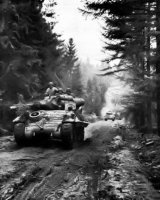OneManGang
Senior Member
- Joined
- Sep 7, 2004
- Messages
- 2,032
- Likes
- 9,653
Tennessee vs The Maxims vs Mississippi State
During the summer of 1978, Joe, a close friend of mine, spent six weeks doing advanced Army ROTC training at scenic Fort Riley, Kansas. Upon his return we got together at Sam & Andy’s on Cumberland. During the course of several pitchers of cold adult malt beverages, he related the following tale. (This is an Official War Story so pull up a helmet or seabag and have a seat!)
This is No Sh*t! (THAT makes it Official!)
It seems one of the cadets in his group hailed from the Magnolia State (that’s Mississippi to you folks in Crab Orchard) and was quite an enthusiastic character. Joe kept noticing that training instructors from other units would seek this guy out and question him then walk away grinning and chuckling. Finally, Joe was close enough to one of these sessions to hear what was going on:
Training instructor, “Cadet! Where do you come from?”
Cadet (shouting), “MISSISSIPPI STATE UNIVERSITY, SERGEANT! HOME OF THE ALLUSTROUS BULLDAWGS! GRRRRR!!!”
This went on throughout the entire camp and the guy did it every time.
Sometimes, football victories are things of beauty, every aspect of the game seems to work and work well. Tennessee's win over South Carolina in 1998 comes to mind. Sometimes, it is a result of stringing together big play after big play, that magic night in Tempe for example. Other times, though, its almost a return to earlier days when men were men and sheep were afraid, three yards and a cloud of dust. The Vols' 190 yards rushing against one of the SEC's better run defenses puts Saturday's win into that category. It was a grinding, methodical game and, as far as the 2019 Vols are concerned, just what the doctor ordered.
In the end, Tennessee wanted it more. Mississippi State (University, home of the Allustrous Bulldawgs! Grrrr!) had a better record, but they just couldn't overcome the Vols. The Vol defense, facing the SEC's leading rusher, did the logical thing and sold out to stop him and dare Mississippi State (University, home of the Allustrous Bulldawgs! Grrrr!) to beat them throwing the ball.
It worked.
* * * * * * * * *
When Julius Caesar led his armies into Gaul (what is now France) the interior of western Europe was one gigantic forest. By 1944, the advances of civilization had reduced this to a few remnants. The largest chunk was a vast woodland called the Ardennes in France and Belgium and the Reichswald on the German side. In September of that year, U.S. First Army was closing in on a corner of these woods This corner had no name at the time, but would become infamous in U.S. Army lore as the Huertgen Forest, named after one of the villages tucked away amidst the trees. On the far side of the forest is the Roer River and beyond that the historic city of Cologne which straddles the Rhine.The historian Charles B. MacDonald, himself a veteran of the Battle of the Bulge described the Huertgen Forest thusly: “Looking east from the little German border villages southeast of Aachen, the Huertgen Forest is a seemingly impenetrable mass, a vast, undulating, blackish-green ocean stretching as far as the eye can see. Upon entering the forest, you want to drop things behind to mark your path, as Hansel and Gretel did with their bread crumbs.”
The path of the American army through Huertgen Forest would be marked by shattered trees, wrecked vehicles, cast off equipment, and dead men.
After breaking out of the Norman bocage country in July, U.S. First Army had roared across France. Under the able command of Gen. Courtney Hodges, First Army actually outstripped the fabled Third Army under Patton. By early September, First Army was approaching the German border and on 11 September, the first Americans crossed into Germany itself. Just behind the border, Hitler had ordered the construction of the Seigfried Line consisting of miles of pillboxes, concrete anti-tank obstacles, barbed wire and mines. All of the towns and villages in the border region also became fortresses as bunkers and pillboxes were built into the buildings. Piercing a fully manned Seigfried Line would be a daunting task.
Fortunately for the approaching Americans the Germans hadn't had the time to bring up more than a few tired and under strength divisions to man the fortifications. However, as one soldiers remarked when told of this by a reporter, “I don't care if he's a syphilitic p**ck who's a hundred years old. He's still sitting behind eight feet of concrete and has enough fingers left to press triggers and shoot bullets.” First Army Intelligence officers would have done well to have heeded this warning.
Unfortunately for the approaching Americans, the dash across France had left their supply lines stretched to the limit. Fuel in particular was a problem. Most of First Army's artillery was far behind the front and would not catch up for another two weeks or so. Replacement men and equipment and badly needed spare parts were somewhere, but nobody was sure exactly where. As a result, both First and Third U.S. Armies were literally running out of gas.
The first town of any size to fall was the medieval town of Aachen. First Army tried to by-pass it and encircle the city, but in the end had to assault it. It was a bitter house-to-house battle and those embedded bunkers proved so tough that self-propelled 155mm guns (equivalent to 6-inch naval guns) had to be rolled up to pound them with their 95 lb shells.
On 14 September the 47th Infantry Regiment of the 9th Infantry Division entered the woods. They made some initial progress but then ran into German fortifications that had been built there several years before and had pretty much disappeared in tangled undergrowth. Far too often the first warning that the men of the 47th heard was the dreaded ripping sound of German machine guns firing from just a few feet away.
The weather worsened as well with cold rain and fog becoming the order of the day. What trails there were became morasses and tanks and trucks were restricted to the few roads and fire breaks which naturally became nearly impassable as treads and tires rolled through. Artillery was nearly useless as forward observers could only see a few yards in the thickets and most of the shells hit the tops of trees as well. The vaunted Allied air power was also useless as from two or three thousand feet at 300 mph, one treetop looked like the thousand or so others in the immediate vicinity.
Sgt. George Morgan of 1st Battalion, 22nd Infantry Regiment recalled, "The forest up there was a helluva eerie place to fight...Show me a man who went through the battle...and who says he never had a feeling of fear, and I'll show you a liar. You can't get all of the dead because you can't find them, and they stay there to remind the guys advancing as to what might hit them. You can't get protection. You can't see...Artillery slashes the trees like a scythe. Everything is tangled. You can scarcely walk. Everybody is cold and wet, and the mixture of cold rain and sleet keeps falling. Then they jump off again, and soon there is only a handful of old men left."
In all, some twelve American divisions were involved in the Huertgen fighting to some extent or another. The 9th, 4th, and 28th bore the brunt of the fighting and each lost at least the equivalent of a full regiment in those woods. The town of Schmidt, near the southern end of the forest changed hands three times.
For their part the Germans were befuddled by the repeated American attacks into the forest when other paths offered themselves. Even allowing for the desire to reach the Roer River and secure the dams upstream, the modern researcher is left asking the same questions.
Historian Charlie MacDonald later wrote bitterly that one reason for this was that during the whole time the infantry was crawling through the meatgrinder of the woods NOT ONE senior American commander ever went to that part of the front. They relied on intelligence reports and sniped at the regimental and divisional commanders for moving too slowly.
The Americans were still stuck in the woods in mid-December when the Germans launched what would become known as the Battle of the Bulge. All attacks in the forest were stopped as every man and tank that could be spared was sent to stop it.
The last of the woods were not cleared until February.
Perhaps Camille Pepin, of the 121st Infantry speaks for all of them, “You got so scared, it wasn’t funny. And let me tell you, there were no atheists in the foxholes — it’s true. It was indescribably dangerous and, looking back, it’s hard to believe you did that. Not because you were a hero. It’s because you were there, and just had to do it.”
*********
So how did the team do compared to the Maxims?1. The team that makes the fewest mistakes will win.
Neither side committed many penalties although the “targeting” call against T'oo T'oo will hurt come Saturday.
2. Play for and make the breaks. When one comes your way … SCORE!
Wasting two scoring opportunities in the first half with errant passes that were intercepted made the game closer than it should have been.
3. If at first the game – or the breaks – go against you, don’t let up … PUT ON MORE STEAM!
After Maurer went out, Tennessee played within itself and executed just well enough to secure the win.
4. Protect our kickers, our quarterback, our lead and our ballgame.
Indeed. Say what you will, but Guarantano did nothing to get the Vols beat.
5. Ball! Oskie! Cover, block, cut and slice, pursue and gang tackle … THIS IS THE WINNING EDGE.
“If you still don't know what to do, hit the guy in front of you.” Your Humble Scribe has been preaching this for five weeks now. FINALLY the big eaters seem to have figured this out. Trey Smith may have had his breakout game and can provide much-needed leadership on the offensive line. 190 yards rushing is a good day's work in anyone's book. Defensive line play has improved beyond all recognition.
6. Press the kicking game. Here is where the breaks are made.
After struggling a bit last week, punter Joe Doyle returned to form and flipped field position a couple of times. Cimaglia went two-for-two on field goals. Good show.
7. Carry the fight to Mississippi State (Unversity, home of the Allustrous Bulldawgs! Grrr!) and keep it there for sixty minutes.
On the button.
Now comes the Mighty Integral that is the Alabama Crimson Tide.
There is only one thing to do: travel to Tuscaloosa and whip hell out of their crimson a**es!
MAXOMG
© 2019 Keeping Your Stories Alive
Suggested Reading:
Charles B. MacDonald, The Battle of the Huertgen Forest
Charles B. MacDonald, The Seigfried Line Campaign. U.S. Army in World War II
Charles B. MacDonald and Sidney T. Matthews, Three Battles: Arnaville, Altuzzo and Schmidt. U.S. Army in World War II
Tank destroyers of the 893rd Tank Destroyer Battalion move up through the Huertgen Forest. (US Army)




